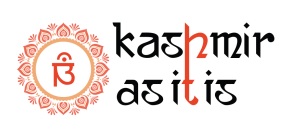Kashmiri Pandits both racially as well as ethinically are known to be the decendants of Kashyp Rishi. It is said that the Kashayp Rishi married the daughters of Daksh called Kadru and Vaneeta. While Kadru gave birth to one thousand powerful naags out of which Vaski Nag, Taksh Nag, Shaish Nag & Kali Nag stood tall, while as Vaneeta gave birth to Arun and Garuda. It is said that in his early age Garuda went to the Himalayas for meditation of Lord Vishnu. One day, both Vaneeta and Kadru were enjoying the sunrise and started discussing the color of the horses of the chariot of Sun God. Kadru said the color was black while Vaneeta was adament on white color. At last there was a bet in which the one who lost will serve other as a her servant. Kadru realised that she lost the bet and was worried that she will have to serve Vaneeta all her life. But her sons assured her that next sunrise they will wrap the horses and she will win the bet. Next morning both the sisters were eagerly waiting for the sunrise, since the horses were now clinged with the black naags, they appeared black and Vaneeta lost the bet and began serving Kadru. In the meantime Garuda came back from his meditation and told his mother that since Lord Vishnu was impressed with his devotion he has been offered to remain with Lord as his Vahan (carrier/ride). Vaneeta was happy for his son and also told him the whole tale of becoming a servant of her own sister. Garuda told Vaneeta that she had been cheated and thus revenge will be taken. On Naradji’s intervention, Garuda decided to go to the Lord Vishnu and ask for a solution. Lord Vishnu granted boon to him saying that the Naags will not have any effect on him and since then the Garuds & Naags became enemies. The serpants did serve the Garudas and in a hope of freeing themselves they started serving Narayana. The story goes on and it is said that the Nag futher remained in that area while as the Garuda flew to the east.
 Thus Kashmiri Pandits are believed to be the residents of Kashmir since the Pro-Regvedic era (1700-1100BC). History of the Kashmiri Pandits starts with the history of Kashmir valley which is more than 11000 years old. Thus the Pandits are responsible for society, culture, civilization, customs, traditions, myths and realities of Kashmir.
Thus Kashmiri Pandits are believed to be the residents of Kashmir since the Pro-Regvedic era (1700-1100BC). History of the Kashmiri Pandits starts with the history of Kashmir valley which is more than 11000 years old. Thus the Pandits are responsible for society, culture, civilization, customs, traditions, myths and realities of Kashmir.
It is said that Kashmir was once filled with the river called Satisar or Saraswati river. Once the cleft at Baramulla appeared and hence the water of river was dried. Now the people living on the banks of the Saraswati river travelled to the Kashmir Valley to continue their austerities. With time they came to be known as Kashmiri Pandits of Kashmiri Battas. The valley of the Kashmir housed many Saints, Sages, Seers by which the community became a believer of Shaivism, Kali, Shakti and Trantra. It is also said by the experts that Kashmir has been the original home of the Aryan race. Kashmiri Pandits have been religiously rooted with Shaivism. It is said that in 400AD a school of Shiv Phylosophy called Pratyabhijna orignated nea Kailasha in Himalayas. This school adopts purely monistic and metaphysical position and is based on the phylosophy that Lord Maheshwara or Shiva is the supreme reality, which is innermost as well as Transcedent. And hence, Kashmir is called as the fountain-head of all the civilization and divine spirituality.
However its been not so long, just from the couple of mellinniums that the race was tried being dominated by other religions and castes. Initially it was Bhuddhism that flourished in North Kashmir housing over 500 monks to attend a Bhuddhist council in the valley during the reign of Durnadeo,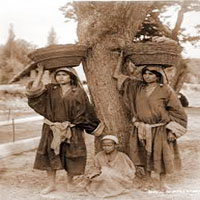 Simhadeo, Sundersen, Ashoka and Kanishka. It is also said that during the reign of Abhimanu in Kashmir the Pandits had to struggle for their survival as large number of their sect was forced to convert into Bhuddhism. History says that some of Kashmiri scholars – Kumarajiva (AD 384-417), Shakyashri Badhra (AD 405), Ratnavera, Shama Bhatta (5th Cen AD) and others went to China and Tibet to preach Buddhism. Then Pandits again gained power with the reign of Nara I which gave a rise to modern Hinduism giving an end to the Pandit- Bhuddhist struggle. However the actual comparative historical validity began with the establishment of the Karkuta rule in AD 627. After him, Avantivarman ruled Kashmir from 855-833AD. He is believed to be first Vaishnaviet rule of the valley and he bought a good cultural development in the valley. Again after couple of centuries, Kashmir struggle with the existence of Pandits against Kayasthas during the reign of Shankara varman. The authority of the Brahmans was broken and the sacred character of their citadels was violated. However, the Shaivite thoughts and philosophy still flourished.
Simhadeo, Sundersen, Ashoka and Kanishka. It is also said that during the reign of Abhimanu in Kashmir the Pandits had to struggle for their survival as large number of their sect was forced to convert into Bhuddhism. History says that some of Kashmiri scholars – Kumarajiva (AD 384-417), Shakyashri Badhra (AD 405), Ratnavera, Shama Bhatta (5th Cen AD) and others went to China and Tibet to preach Buddhism. Then Pandits again gained power with the reign of Nara I which gave a rise to modern Hinduism giving an end to the Pandit- Bhuddhist struggle. However the actual comparative historical validity began with the establishment of the Karkuta rule in AD 627. After him, Avantivarman ruled Kashmir from 855-833AD. He is believed to be first Vaishnaviet rule of the valley and he bought a good cultural development in the valley. Again after couple of centuries, Kashmir struggle with the existence of Pandits against Kayasthas during the reign of Shankara varman. The authority of the Brahmans was broken and the sacred character of their citadels was violated. However, the Shaivite thoughts and philosophy still flourished.
Then during the reign of Lohara dynasty, Kashmir came under the influence of Islam. When Mehmud Ghazni annexed Punjab, most of the Kashmiri Pandits converted into Islam for the sake of their lives. At that time, the Valley was ruled by Sangram Raja (AD 1003-1028). Even after their conversion to Islam, these people continued to visit Kashmir – as traders, wanderers and even missionaries. It is also said some of the converties stayed in the valley propogating their new religion. Similar things happened in the reign of Harsha (AD 1089-1101); Gopadeva (AD 1171-1180); Jassaka (AD 1180-1198) where the temple treasuries were depleted and Islam started to consolidate its roots. Roots of Pandits were shattered again and they were never allowed to monopolize.In the reign of Jassaka (AD 1180-1198), two Brahmans – Kshuksa and Bhima, endeavored to capture the throne. But it was the fear of Damaras or feudal lords that prevented them. Ramadeva (AD 1252-1273) humiliated those Brahmans who had helped him in his coronation. They conspired against him but could not succeed. A reign of terror, loot and plunder was let loose against them. Many Brahmans were killed and others crushed barbarously. This was the first direct assault against them in the history of Kashmir. To save themselves they cried “ Na Batoham” (I am not a Bhatta).
The Kashmiri Pandits are even now taunted as Bhattas and Dalli 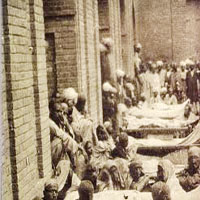 Bhattas. During the reign of Suhadeva (AD 1301-1320) many Muslim adventurers came to Kashmir. The chief among them was a Muslim missionary- Bulbul Shah. Dulucha, a Tartar chief from Central Asia, invaded Kashmir with 60,000 strong horsemen. Suhadeva tried to induce him to retreat by paying him off a large sum of money by imposing heavy taxes on Pandits who till then never lived by paying taxes. Dulucha denied the offer and continued the terror attacks. As mentioned in Baharistan – i -Shahi; Dulucha and his army men killed every men they found, women and children were made slaves and were sold to the merchants of Turkistan. Suhadev fled to Kishtawar and Dulucha looted kashmir for eight months. It is said that he took with him 500,000 pandits as slaves. There were only few cursed Pandit families left in the haunted valley blaming their ruler Suhadeva for the mishap. Taking the advantage of this, a pseudo- Buddhist from Tibet occupied the throne. Since he wanted to wanted to get initiated into the Brahmanical fold to strengthen his political position, he called religious head to indoctrinate himself into the Hindu religion. But the Pandits denied and refused to accept him as a Hindu because of his low birth. Pandits were not ready to share their “Panditsm” with any outsider. However taking advantage of this Shahmir and Bulbul Shah (missionaries from Islam) manipulated his conversion into Islam and thus the Muslim ruling in Kashmir came into existence. During his rule, people of poorer families and subdued casts were gradually converted into Islam.
Bhattas. During the reign of Suhadeva (AD 1301-1320) many Muslim adventurers came to Kashmir. The chief among them was a Muslim missionary- Bulbul Shah. Dulucha, a Tartar chief from Central Asia, invaded Kashmir with 60,000 strong horsemen. Suhadeva tried to induce him to retreat by paying him off a large sum of money by imposing heavy taxes on Pandits who till then never lived by paying taxes. Dulucha denied the offer and continued the terror attacks. As mentioned in Baharistan – i -Shahi; Dulucha and his army men killed every men they found, women and children were made slaves and were sold to the merchants of Turkistan. Suhadev fled to Kishtawar and Dulucha looted kashmir for eight months. It is said that he took with him 500,000 pandits as slaves. There were only few cursed Pandit families left in the haunted valley blaming their ruler Suhadeva for the mishap. Taking the advantage of this, a pseudo- Buddhist from Tibet occupied the throne. Since he wanted to wanted to get initiated into the Brahmanical fold to strengthen his political position, he called religious head to indoctrinate himself into the Hindu religion. But the Pandits denied and refused to accept him as a Hindu because of his low birth. Pandits were not ready to share their “Panditsm” with any outsider. However taking advantage of this Shahmir and Bulbul Shah (missionaries from Islam) manipulated his conversion into Islam and thus the Muslim ruling in Kashmir came into existence. During his rule, people of poorer families and subdued casts were gradually converted into Islam.
In AD 1339, Shahmir ascended the throne of Kashmir by a foul play. He got khutaba read and the coins struck to his name and hence Islam became the court religion of Kashmir. Thus he became the author as well as the architect of the valley. During his reign Muslim missionaries, preachers, sayyids and saints penetrated into the Valley. Gradually threat to the Pandit community due to the establishment of Islam and gradual conversion led to a frail rebellion during the reign of Shihab-ud-Din (AD 1354-1373). This annoyed the king so much so that the poor Pandits had to pay a huge amount. Pandit temples became a new target of the Muslim rulers. Many temples of historic importance including that of Brijbhihara were wrecked.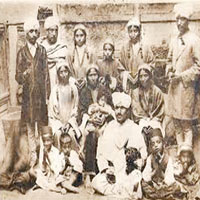 The Hindus began to feel deserted and alienated in their own land. To make their roots more stronger in the valley, Muslim rulers passed a law called the “policy of extermination” which meant to eradicate all traces of Hinduism in any form. During this period many Pandits stuck with their religion without fear however many of them also converted for the sake of their lives or to gain royal favors. The converted Pandits have been looked inferior, traitorous and treacherous, with no loyalty towards their community. The King was now not interested in his ministry affrairs rather he felt delighted in causing pain to Pandits. Its said he took delight in breaking the images of Martanda, Vishaya, Ishana, Chakrabrit and Tripureshvara.
The Hindus began to feel deserted and alienated in their own land. To make their roots more stronger in the valley, Muslim rulers passed a law called the “policy of extermination” which meant to eradicate all traces of Hinduism in any form. During this period many Pandits stuck with their religion without fear however many of them also converted for the sake of their lives or to gain royal favors. The converted Pandits have been looked inferior, traitorous and treacherous, with no loyalty towards their community. The King was now not interested in his ministry affrairs rather he felt delighted in causing pain to Pandits. Its said he took delight in breaking the images of Martanda, Vishaya, Ishana, Chakrabrit and Tripureshvara.
There was no city, no town, no village, no wood where Turushka left the temples of the gods unbroken.It is said that the valley was so enriched with the fine workmenship of the magnificant temple structures that the King Sikandar was biwildered after having a sight. Sikandar, goaded by feelings of bigotry, destroyed them and levelled them with the earth and with the material built many mosques and khanqahs.He started his regime of destroying the temples from Martand temple (Built by Ramdeva and then rebuilt by King Lalitaditya, AD 724-760). It is said that when the king failed to demolish the temple in one year, he dug out stones from its base and having stored enough wood in their place, set fire to it. The gold gilt paintings on its walls were totally destroyed and the walls surrounding its premises were demolished. Its ruins even now strike wonder in men’s minds. On the similar lines the Vijiveshwara temple, was damaged and material collected from this site was used to built the mosque at the Khanqah, which is now known as Vijiveshwara mosque. It was notified that the Pandits either need to convert to Islam or get killed. As a result some Pandits fled from the valley and few convereted and those who retaliated were brutally murdered.
Then came the rule of the Mughals. Akbar was said to be tremendously influenced by the amazing moral supremacy of the Kashmiri Pandits.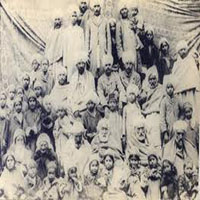 As recorded in Ain-i-Akbari, “the most respectable class in this country (Kashmir) is that of the Pandits, who, notwithstanding their need for freedom from the bonds of tradition and custom, are the true worshippers of God. They do not loosen their tongue of calumny against those not of their faith, nor beg, nor importune. They employ themselves in planting fruit trees and are generally a source of inspiration for others”. The greatness of Akbar lies in his magnificent and fascinating policy of religious tolerance. Jahangir and Shah Jahan were not so tolerant. But their religious enthusiasm cannot be termed as fanatic. During this period, the Brahmans could perform their religious ceremonies after paying some tribute. But the whole scenario changed with the accession of Aurangzeb to the throne. With his bigoted fanatic and dogmatic approach, the Kashmiri Pandits were once again made vulnerable. Aurengzeb terrorized Pandits and it was the fourth disastrous mass exodus of the Aryan Saraswat Brahmans from Kashmir. During the rule of later Mughals, Kashmir witnessed the outbreak of the worst kind of religious intolerance.In AD 1720, Mullah Abdul Nabi, also called Muhat Khan, a non-resident Kashmiri Muslim, was appointed as Shaikhul Islam . . In order to satisfy his satanic ego, the Mulla issued six commandments:
As recorded in Ain-i-Akbari, “the most respectable class in this country (Kashmir) is that of the Pandits, who, notwithstanding their need for freedom from the bonds of tradition and custom, are the true worshippers of God. They do not loosen their tongue of calumny against those not of their faith, nor beg, nor importune. They employ themselves in planting fruit trees and are generally a source of inspiration for others”. The greatness of Akbar lies in his magnificent and fascinating policy of religious tolerance. Jahangir and Shah Jahan were not so tolerant. But their religious enthusiasm cannot be termed as fanatic. During this period, the Brahmans could perform their religious ceremonies after paying some tribute. But the whole scenario changed with the accession of Aurangzeb to the throne. With his bigoted fanatic and dogmatic approach, the Kashmiri Pandits were once again made vulnerable. Aurengzeb terrorized Pandits and it was the fourth disastrous mass exodus of the Aryan Saraswat Brahmans from Kashmir. During the rule of later Mughals, Kashmir witnessed the outbreak of the worst kind of religious intolerance.In AD 1720, Mullah Abdul Nabi, also called Muhat Khan, a non-resident Kashmiri Muslim, was appointed as Shaikhul Islam . . In order to satisfy his satanic ego, the Mulla issued six commandments:
1.No Hindu should ride a horse, nor should a Hindu wear a shoe;
2.That they should not wear Jama (Mughal costume);
3.That they should move bare arms;
4.That they should not visit any garden;
5.That they should not have tilak mark on their foreheads;
6.That their children should not receive any education.
But the Deputy Governer disagreed, however the Mullah was able to excite his followers against Pandits and made sure that these commandments were follwed. The Pandits were wickedly tormented, their houses burnt and property looted. Hundreds of Brahmans were killed, prostrated, maimed and humiliated. Pandit parents destroyed the beauty of their daughters by shaving their heads or cutting their noses and ears to save them from degradation.
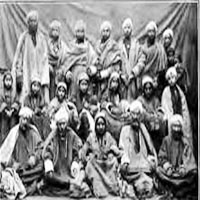
There was horrible mass exodus of the Kashmiri Pandits, sixth one. It is because of these tortures the Afghans are now only remembered for their barbarity, brutality, ferocity, tyranny and cruelty. It was then during the Sikh rule in Kashmir, AD 1819-1846, the celebrated Pandits reclaimed their past glory and magnificence. With the formation of Jammu and Kashmir State; and, establishment of the Dogra rule in 1846, Kashmiri Pandits were imperceptibly elbowed to the background.Administrators and officials were deputed from Jammu region. Though they enjoyed comprehensive religious freedom and social emancipation, political rights of the Kashmiri Pandits were confined. After independence and accession of Jammu & Kashmir state to India, Kashmiri Pandits were pushed back to the uncultured Afghan era. The administration of Shaikh Abdullah adopted malicious and pernicious approach towards the Saraswat Pandits of Kashmir. They were taunted on one excuse or the other. Hindu temples were desecrated, looted and plundered. Minor girls of the community were forced to embrace Islam and marry the Muslim youth.During 1953-1974 Shaikh Abdullah characterized India as an imperialist power endeavouring to subjugate the people of Kashmir. He asserted that the accession of Kashmir with India was his greatest blunder for which history will never forgive him. He also campaigned against the import of food grains from India and asked people to eat potatoes grown in Kashmir. Thus he was also known as “Aalo Bab”.
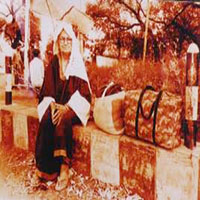
During his period of so called Sheikhdom, he was attrested many times, once in 1953 for anti-national activity however was relased in 1958. He was rearrested after 3 months of his release for “Kashmir conspiracy case” however the charges were dropped in 1964. But he was arrested again in May 1965 for his subversive activities and released in January 1968. Again, in January 1971, a ban was imposed forbidding him to enter the Jammu Kashmir state.This restriction was lifted in 1972. He made emotional solicitations that after death his body should not be buried in the subjugated Valley, but immersed into the sacred waters of Arabian sea. However, today his magnificent tomb stands on the banks of beautiful Dal Lake in Srinagar and is guarded by the Indian security personnel.But then the whole political scenario in Kashmir took a dramatic turn in 1974, when Indira-Shaikh accord was signed by virtue of which the Shaikh became the Chief Minister of the State after the lapse of 22 years.The sophist Shaikh began to speak the language of Indian nationalism, democracy, socialism and secularism. But hate India virus had already infected people of the state. And the History repeated itself with the mass exodus of Pandits in 1989-1990.
Forced Migrations (Exiles) have been part and parcel of Kashmiri Pandits lives. During the migrations, large concentration of Kashmiri Pandits settled in Lahore, Delhi, Agra, Lucknow, Hardoi, Kanpur, Allahabad, Gwalior, Jaipur and Jodhpur. Substantial numbers were also found in Shimla, Ambala, Multan, Ajmer, Dehradun, Ujjain, Indore, Bhopal and Cuttack.
First Exodus
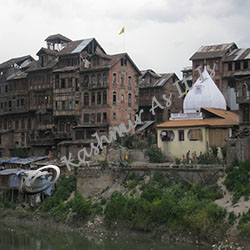 When Shahmir ascended the throne of Kashmir in 1339AD he got Khutba and coins struck to his name and became the architect of Muslim rule in Kashmir. He called muslim missionaries, preachers, sayyid and saints in the valley who lived under royal protection and disseminated the message of Islam. It is said that during this period there was a set of rules issued for the Pandits which include:
When Shahmir ascended the throne of Kashmir in 1339AD he got Khutba and coins struck to his name and became the architect of Muslim rule in Kashmir. He called muslim missionaries, preachers, sayyid and saints in the valley who lived under royal protection and disseminated the message of Islam. It is said that during this period there was a set of rules issued for the Pandits which include:
1. Muslim ruler shall not allow fresh constructions of Hindu temples and shrines for image worship.
2. No repair shall be executed to the existing Hindu temples and shrines.
3.Pandits shall not proffer Muslim names.
4. Pandits shall not ride a harnessed horse.
5. Pandits shall not move about with arms.
6. Pandits shall not wear rings with diamonds.
7. Pandits shall not deal in or eat bacon.
8. Pandits shall not exhibit idolatrous images.
9. Pandits shall not built houses in the neighbourhood of Muslims.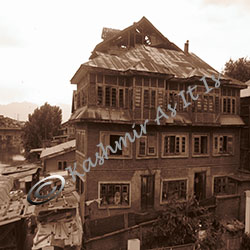
Ruines of Kashmiri Pandit Homes
10. Pandits shall not dispose of their dead in the neighbourhood of Muslim graveyards, nor weep or wail over their dead.
11. Pandits shall not deal in or buy Muslim slaves.
12. No Muslim traveller shall be refused lodging in the Hindu temples and shrines where he shall be treated as a guest for three days by non-Muslims.
13. No non-Muslim shall act as a spy in the Muslim state.
14. No problem shall be created for those non-Muslims who, of their own will, show their readiness for Islam.
15. Non-Muslims shall honour Muslims and shall leave their assembly whenever the Muslims enter the premises.
16. The dress of non-Muslims shall be different from that of Muslims to distinguish themselves.
Although there was a rebellion from the Pandits but the King was easily able to supress it. In return to this rebel the Pandits had to pay a huge price which started of with the demolishing of the temples and making mosques from that material, destroying of the hindu god metal idols and using the melted metal to make coins and last but not the least imposing Jazia (religious tax) on the Pandits. The Pandits were being haunted with brutality, barbarism and vandalism. All the Hindu books and manuscripts were collected and buried in Dal Lake under a huge rock. Either the Pandit had to abandon their religion or their country else they could never escape the evil punishment which was death. It is said that six mauds of sacred thread called Janau was collected from the converted Pandits and seven mauds was collected from the assasinated Pandits. These thirteen mauds of the sacred thread were then burnt. Due to the fear of banishment a mamoth number of Pandits went into exile causing the first mass exodus.
Second Exodus
In the reign of Ali Shah (AD 1413-1430), son of Sikandar Butshikan, homicides, conversions, tyranny and enforced jazia became the plight of Kashmiri Pandits.
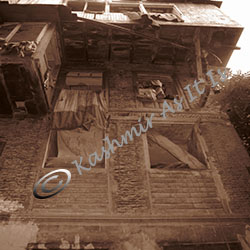
Suha Bhatta, a converted kashmiri Pandit, became envious to the Brahmans who decided not to change their caste and thus participated with Ali Shah in his draconian reign against Pandits. He was aware that in order to protect their caste the Pandits are fled to different parts of the country, therefore he ordered the squads to be posted on the roads and kill any Pandit who is found crossing by. The country was now filled with hatered against the Pandits. Thus now the Pandits had no other option other than running from the bye roads as the main roads has been closed by the army men. While their exodus Pandits were oppressed by clamities, encounter with enemies, snakes, heat and scanty food. This was the second miserable exodus. This was also called “Chandh – Dandh” – a voilent, brutal and horrible punishment for abandoned and vulnerable Kashmiri Pandits.
Third Exodus
It was in AD 1477 when Mir Shams-ud-din Iraqi, the founder of the Shia sect visited Kashmir. His main aim was propogation of Inslamic faith in Kashmir. He with Malik Musa Raina another convertee, applied all sorts of voilent methods to convert people into Shia sect. Not only Pandits but the people of Sunni sect were also not spared.It is said that about 24000 Pandis were converted using murderous techniques. Every day 1000-1500 pandits were bought to the doorsteps of Mir and they were forcibly asked to remove their Janau, read Kalima and eat beef. Thousands of Pandits killed themselves and thousands migrated to other parts of the world. Those who did not convert or did not leave were forced to pay Jazia and their nose and ears were chopped off.
Fourth Exodus
The reign of Akbar was a golden period for Kashmiri Pandits as he believed in religious tolerance. 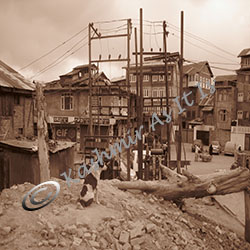 However his successors Jahangir and Shah Jahan were not so tolerant, but still they were not fanatics and allowed brahmans to perform religious ceremonies afetr paying some tribute to the king.
However his successors Jahangir and Shah Jahan were not so tolerant, but still they were not fanatics and allowed brahmans to perform religious ceremonies afetr paying some tribute to the king.
But the whole scenario changed when Aurangzed occupied the throne. With his fanatic and dogmatic approach he again made the lives of Kashmiri Pandits vulnerable. Pandits were so much so horrified that they approached Guru Teg Bahadur and requested his intervention with the emporer. This ultimately led to the Guru’s martyrdom and made Guru Gobid Singh to create the Khalsa to fight the oppressors. Hence the Pandits again were ferociously terrorized and these scapegoats again had to leave the country.
Fifth Exodus
Again during the reign of Mullah Abdul Nabi, who was appointed as Shaikhul Islam in AD 1720, same rules (as mentioned in first Migration) were imposed. He started his implementation of his evil plans with starting a campaign of persecution of Kafirs or Kashmiri Pandits. He assumed the high seat in the mosque and excited the Islam followers against Pandits. Hundreds of Brahmans were killed, prostrated, maimed and humiliated. They began to run away in large numbers and hide themselves in mountainous terrain. This was the fifth dreadful mass exodus of the legendary Kashmiri Pandits from their mystic motherland. Those who remained behind lived in the most horrific and terrible conditions generated by the Mullah and his gang.
Sixth Exodus
It was the time when Kashmir fell into the hands of the Afgan rulers (AD 1753 – 1819). This was the period of cruelty, homicide and anarchy. The barbarous Afghans employed every wild, inhuman, primitive, ferocious, cruel and brutal method to suppress the Kashmiri Pandit. A pitcher filled with ordure was placed on the head of a Pandit and stones were pelt on it, till it broke and the unfortunate Brahman become wet with filth. Their brutality and atrocity crossed the extreme limits when Hindus were tied up in grass sacks, two and two, and drowned in the Dal Lake. The victimized Hindu were forced to flee the country or were killed or converted to Islam.
There was horrible mass exodus of the Kashmiri Pandits, sixth one, to far away places like Delhi, Allahabad, etc. Many covered the long distances on foot. 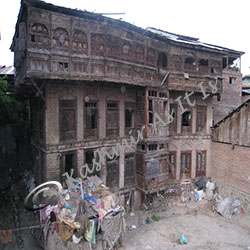 Hindu parents shaved off their daughters and cut their noses to save them from being abused. An ordeal was passed that there should be the use of the leather bags and not grass bags while drowing a Pandit. This period is rememberd more as their period of cutting heads than of plucking flowers.
Hindu parents shaved off their daughters and cut their noses to save them from being abused. An ordeal was passed that there should be the use of the leather bags and not grass bags while drowing a Pandit. This period is rememberd more as their period of cutting heads than of plucking flowers.
Seventh Exodus
With the formation of Jammu & Kashmir state in 1846 and establishment of Dogra rule, the Pandits were now able to enjoy religious freedom and social emancipation; however the social rights of the Pandits were still confined as they became the victims of intrigue and suspicions. There was also a communal wrath against them. In July, 1931, during the major communal disturbance, Pandits were the main sufferers. Their shops and houses were not only looted but they were also killed.
Gradually after independence, in the administration of Shaikh Abdullah, article 370 was imposed to cipher and liquidate their population. The Pandits were again pushed to the Afghan era. Hindu temples were looted and girls were asked to forcibly marry Muslim youth and convert into Islam. As discussed in the “History” page Shaikh adopted malicious and pernicious approach towards Pandits. From 1947-1986 about four lac Kashmiri Pandits silently migrated from Kashmir.
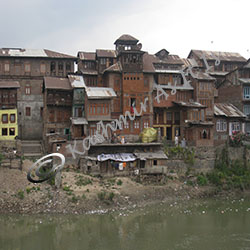 Hypocritical atrocities and criminal ignorances of political leaders were responsible for these development. Pakistan, to avenge the defeat of Bangladesh, blatantly sponsored the violence and terrorism in the Valley, resulting in the turmoil of 1989-90. Final assault on Kashmiri Pandts started off with these slogans:
Hypocritical atrocities and criminal ignorances of political leaders were responsible for these development. Pakistan, to avenge the defeat of Bangladesh, blatantly sponsored the violence and terrorism in the Valley, resulting in the turmoil of 1989-90. Final assault on Kashmiri Pandts started off with these slogans:
“Aay Zalimu, Aay Kafiroo,Kashmir Hamara Choudh Dou”
“Bharat Kay Aiwanu Ko, Aag Lagado, Aag Lagado”
Brutal and wild techniques were employed to hound and kill Kashmiri Pandits. Helpless ladies were gang raped infront of their husbands and then killed. The murder of hundreds of innocent Pandits marked the seventh and the final mass exodus from the valley. This was not enough, still the ethnic cleansing of the Kashmiri Pandits is being carried in the valley. The mass massacres at Sangrampora (1997), Udhampore (1997), Prankot (1998), Wandhama (1998) and Nadimarg (2003) were the results of these cleansing operations. Its been 22 years now, but still the government has failed to express any serious concern at this Human Tragedy.
Contributed by – Dr. Satish Ganjoo
Pictures – Family album
The article has been originally written by Dr. Satish Ganjoo and therefore we have not made any amendments in the article.
In the original article the word ‘Migration‘ has been used, however after taking confirmation from Dr. Ganjoo; it has been changed to ‘Exodus‘
Any concerns please email to admin@kashmirasitis.com
| Name of the monument | Location | District |
| Ancient site of Chakradhar / Semthan | Semthan | Anantnag |
| Mughal Arcad and Spjring at Verinag | Verinag |
Anantnag |
|
Martanda (Sun Temple) |
Ranbirpura |
Anantnag |
| Bumzuva Cave and Temple |
Bumzuva |
Anantnag |
|
Detah Mandir |
Bandi |
Baramulla |
|
Ancient Temple |
Buniyar |
Baramulla |
|
Ancient Temple |
Fatehgarh |
Baramulla |
|
Ancient Stupa (Excavated Remains) |
Ushkur |
Baramulla |
|
Partapswami Temple |
Tapparwaripor |
Baramulla |
|
Sankaragaurisvara Temple |
Pattan |
Baramulla |
|
Sugandhesa Temple |
Pattan |
Baramulla |
|
Ancient Stupa, Chaitya & Monastery |
Dever Yakhamanpjor / Parihaspjora |
Baramulla |
|
Ancient Site |
Sumbal |
Baramulla |
|
Mosque and other ancient remains on the island |
Nular Lake |
Baramulla |
|
Khanpur Sarai |
Khanpur |
Budgam |
| Aliabad Sarai | Aliabad | Pulwama |
| Avantiswami Temple | Avantipura | Pulwama |
| Avantisvara Temple | Avantipura |
Pulwama |
|
Hirpur Sarai |
Hirpur |
Pulwama |
|
Ancient Temple |
Kakapora |
Pulwama |
| Monolithic Shrine | Khrew | Pulwama |
| Remains of Ancient Temple | Khrew | Pulwama |
| Ancient Temple | Loduv | Pulwama |
| Remains of Ancient Stupa |
Malangpora |
Pulwama |
|
Remains of Ancient Temple |
Pampur |
Pulwama |
|
Ancient Siva Temple |
Payar |
Pulwama |
|
Pathar Masjid |
Zaina Kadal |
Srinagar |
|
Ancient Temple |
Bohri Kadal |
Srinagar |
| Tomb of Zain-ul-Abudin’s mother | Zaina Kadal | Srinagar |
| Khan Qah of Shah Handan |
Shah Handan |
Srinagar |
| Akhund Mulla Shah’s Mosque | Kathi Darwaza | Srinagar |
|
Gates in the Rampart of the fort a) Kathi Darwaza b) Sangen Darwaza |
Kathi Darwaza Sangen Darwaza |
Srinagar |
|
Ancient Temple |
Hari Parvat |
Srinagar |
| Group of Ancient Temples |
Naranag |
Srinagar |
|
Ancient sites & Remains |
Burzahom |
Srinagar |
|
Ancient Monastery & Stupa |
Harwan | Srinagar |
| Group of arched terraces / structural complex | Pari Mahal | Srinagar |
| Shankaracharya Temple |
Kothi Bagh / Durganag |
Srinagar |
|
Ancient Site |
Pandrethan |
Srinagar |
| Excavated Remains | Pandrethan | Srinagar |
| Pandrethan Temple | Pandrethan | Srinagar |
Credits: Archeological Survey of India
Bakaya – An officer of the rank of a Tehsildar was appointed in the time of Sikhs and Pathans to realise the outstanding taxes from the people. His descendants were nicknamed as Bakaya.
Bakshi – It is a common Punjabi surname. A Pandit employed as an Assistant to a Punjabi officer, having Bakshi his surname, he was also known as Bakshi. The Pandits employed as a clerk of the Army were known as Bakshi or Mir Bakshi.
Munshi – It is a common surname among many linguistic groups of India. It is said that a certain Pandit of Tikoo family was employed as a Munshi during the rule of Sikhs or Pathans. He was the most intelligent and efficient Munshi Kashmir had ever seen. Therefore, he became famous by his professional name and his children were also known by this name.
Wazir – The Pandits employed in the service of Wazirs of Kashmir during Pathan and Mughal rule became gradually famous by the name of Wazir.
Chakbast – ‘Chak’ in Kashmiri is the name given to a large piece of land. Chakdari was a common feature of Kashmir’s agrarian system. It was abolished after the end of Dogra regime in 1948. Before the passing of Agrarian laws large pieces of land would be given to influential zamindars as the ‘Chaks’ on a nominal rent. Therefore, the officers entrusted with the job of keeping a regular- account of these land holdings were known as ‘Chakbast.’ They were also known as Kanoongo.
Bhan – It is an ancient Kashmiri nickname given, for those who live in “Bhan’a’mohalla”. Sun is also known as Bhanu. It is said that mohalla was having “Siri – Kund” – The water reservoir dedicated to Sun God. As per the elders there also was a tree covering this kund which has a mythical significance.
Pandita – All the Kashmiri Hindus were mainly called ‘Pandits’ thus Pandita surname derived from the word ‘Pandit’ is very common in Kashmiris. Also some of the converted muslim Kashmiri write it as ‘Pandith’.
Langar or Langroo – Some of their ancestor must have been the manager of a Government kitchen. His descendants were, therefore, nicknamed Langar or Langroo.
Wattal – It is a very derogatory term and is used for a low caste tribe. It is also used for a person who indulges into very mean and lowly acts. It is presumed that some Pandit must have been appointed as an officer of Wattals, who himself was later on known by this very name. Fauq says that during Hindu rule many people swept the premises of temples, without any compensation, out of devotion to the presiding deity of the temple. They and their descendants were later nicknamed as Wattal. One more theory being forwarded is that the Pandits whose family name is Wattal are the descendants of some famous saint by the name of Wattal Nath.
Bazaz – Some ancestor of the family must have been a cloth merchant.
Taimini – It is presumed some Pandit must have been under the service of Taimini Pathans of Kabul and earned this nickname. Fauq believes it to be a word of Hindu or Buddhist origin and considers this family to be the followers of some Rishi or Muni. At the same time, it is suspected that some ancestor of this family might have been of black colour, and was called Tamini as the Tamun in Kashmiri means the carbon formed on the bottom of the utensils.
Mattu – It is derived from the Sanskrit word Math. Some of the ancestor of this family must have either been a founder or a manager of some Math.
Chak – Employees of Chak Kings.
Zalpuri – Employees of traders from Zablistan. It is often mispronounced out of Kashmir as Zalpari.
Khar – It means an ass in Kashmiri. A Pandit employed to realise taxes from donkey drivers (Markaban).
Hazari – A servant of Hazari Pathan’s got this nickname.
Zutshi – It is a corrupt form of the word Jyotshi. Zutshis are reported to have been distinguished astrologers and Sanskrit scholars.
Razdan – The census report of 1819 states that Razdan is a corrupted form of ancient Sanskrit epithet Rajanak. Stein is of the view that ‘the title Rajanak, meaning literaly “a king”, used to be given for services rendered to the King. The title has survived in the form of Razdan as a family name of very free occurrence among the Brahmans of Kashmir. It was borne by Rajanaka Ratanakara, the author of the Haravijaya (9th Century), and by many Kashmirian authors of note enumerated in the Vamsaprasasti which Anama Rajanaka (17th Century) has appended to his commentary on the Nisadhacarita. As the designation of certain high officials (Muhammadans), the term Rajanaka is often used by Srivara and in the fourth chron (also in the shortened form Rajana).’ R. S. Pandit states that the title Rajanaka was continued under Muhammadan rule and was conferred on Muslim officers.
Tikoo – It is said to have originated from the ‘Trika’. The members of this family were special devotees of the goddess ‘Tripura’. Fauq has given one more explanation stating that an ancestor of this family adopted a non-Brahman boy who was deemed to have become a Brahman by a Tika (a sacred mark on the forehead of a Brahman). He and his descendants were later nicknamed as Tiku. Kathju – Pandit family residing at Kathleshwar in Tanki Pora (a mohalla of Srinagar) was nicknamed Kathju.
Sopori – Pandits of Srinagar, whose ancestors migrated from Sopore, or the descendants of Soya Pandit (founder of Sopore) were known as Sopori. Kashmiri Pandits of this nickname in plains have hanged the word Sopori into Shivpori.
Thussoo – Emigrants from a village Thus, in Kulgam Tehsil, to the Srinagar city became known by the name of their native village.
Sapru – Dr. Iqbal, who was the worthy descendant of a Pandit family whose surname was Sapru, wrote to Mr. Fauq about the word Sapru as follows. He wrote that Mr. Dewan Tek Chand M.A., who was a Commissioner in Punjab, had a taste for linguistic research. He told Mr. Iqbal that the word Sapru had its genesis from the Ancient Iranian Kings ‘Shapur’. Saprus are those Iranians who had settled down in Kashmir much before the advent of Islam and because of their sharp intellect were absorbed soon with Brahmans of Kashmir. Dr. Iqbal has further written that his father used to say that ‘Saprus’ are the descendants of those Kashmiri Brahman families who were first to learn Persian and other Islamic studies, during the Muslim rule. Sapru means a person who is first to learn a new thing. This name was given to them out of contempt by other Brahmans. The latter analysis is nearer in the approach of a common Kashmiri and the former assertion needs full investigation.
Haksar – Emigrants from a village named Hakchar in district Baramullah.
Raina – It is stated that the Pandits who originally belonged to Rainawari and later settled down in the main city were known as Raina.
Razdan – Another view expressed is that it, like Razdan, is a corrupted form of the title Rajanaka.
Waloo or Wali – A fire chimney in Kashmiri is called Wol. One who got constructed a fire chimney in his house at first was immediately nicknamed as Wol, which in due course of time became, Waloo and Wali.
Wantu/Wanchu – Wantu in Kashmiri is used for a hard walnut. It is impossible to get a full Kernel (GIRI) out of a hard walnut, even if it is broken into pieces. Some of the ancestor of this family must have been a top class miser and was compared to a ‘Wont doon’ (hard walnut). Thus was this nickname started to continue for generations.
Gamkhwar – A Pandit was a born sympathiser. He would share the sorrow of one and all. Somebody out of envey nicknamed him Gamkhar. It is said that Sadanand Koul was given the title of Gamkhar by the Mughal King Shah Jahan. His progeny was also known by this title.
Kak – An elder brother, uncle or a cousin was out of reverence called as Kakh. Some Pandit for his good and generous nature seems to have won the public respect and was called Kakh by the people, other than his family members. He lost his real appellation and was along with his progeny known as Kak. However, there are repeated references of the family name Kak in Rajtarangini.
Mushran – An awkward and ugly man with a huge and powerful body is called Mushran. Some ancestor of this family must have been nicknamed as mushran because of his unusual physique and, later his descendants continued to be called by this name.
Sharga – It is corrupt form of Shogo (a parrot). Some member of the family was having small eyes and a long nose like a parrot.
Handoo – This nickname was given to a Pandit who was fat and fresh like a sheep or to those Pandits who somehow were connected with flocks of sheep.
Gurtu – It is a nickname given, perhaps, to those Razdans whose some ancestor was of Gurtu (yellow) colour. Gurtu is now used for those Pandits who do not cook meat and fish on the Shivratri festival.
Kichloo – It means a long-beared in Kashmiri Some elder of the family must have developed a long beard and received this nickname.
Ganjoo – A bald man’s nickname or an appellation for a man who was put in-charge of Ganj (treasury).
Dhar – It is stated to be a pure gotra name. Dhar Bharadvaja is the name of their gotra. However, many scholars are of the view that Dhars are the descendants of Damras, the war lords and a troublesome non-Brahmanic tribe of ancient Kashmir.
Aarm – They were known to be the tax collectors from the vegetable growers. In Rajtarangini these guys are also called as Aramak.
Kral – This surname was given to the people who lived in the localities like Kralpur, Kralgund, Kral Khod etc. Also this was the nickname given to the potters.
Gooru – Although the milkman is called Goor in Kashmiri, however since the Pandit did never do a job of the milkman, therefore, the Pandits who collected and maintained the tax accounts collected of the cattle of the Patwaris became known as Gooru.
Manwati – An official who collected tax of one Manwati (which literally used to be a standard weight in Kashmiri equal to two and a half seers) of rice on the tenants. His descendants also lost their original family name and the nickname Manwati became an irremovable attachment to their names.
Guzarwan – An official incharge of an excise check-post on the outskirts of a town was called Guzarwan. Thus, his children no matter whatever profession they chose they became famous with this name.
Jawansher – Jawansher was a famous Afghan Governor of Kashmir. He had a Pandit as his Peshkar (Assistant) who became famous by the name of his master. Jawansher is the nickname of many families bearing different surnames.
Misri – A Pandit employed in service of a trader who had come from the Egypt (Misr) was known by the nickname Misri.
Turki – A Pandit employed as a clerk by a Turk trader.
Gandnoo – A Pandit who was involved in the selling of ‘Gandan dasta’ and ‘posh gond’ was nicknamed as Gandnoo.
Kuli – Pandits those were employed under Afghan officers Tarkuli Khan and Noor Kuli Khan were nicknamed as Kuli.
Ambardar – Pandits who were employed to take care of the huge rice stores called AMBAR were nicknamed as Ambardar.
Langar / Langroo – Nickname given to the employess who managed government kitchens.
Fotedar – This name was given to the Pandits who were trusted to take care of Royal Treasury.
Hakim – This name was given to those whose ancestors were Hakims or Doctors.
Waza – This nickname was given to the professional cooks.
Katwa – This nickname was given to the branch of cooks who were in a habit of using small Patilis for cooking.
Sultan – The actual family name is kouls, however since they were employed as the clerks for Sultans, they got this name.
Nala – The ancestors the family might have been a guards or living by the Rivulet called Nala.
Nehru – This name was given to the Pandits living near the cannal. They originally belonged to Koul clan however were called Naroo which means pipe.
Taimani – The pandits who were in service of the Taimani Pathans got this nickname. It is also suspected that the ancestors of this family might have been black in color and thus they were called Taimani since Tamun means black carbon formed under utensils.
Mattu – Mattu is derived from sanskrit word Math, Pandits who were founder or manager or Maths were called Mattus.
Darbari – Pandits who were the courtier of the Pathans were called Darbaris.
Bhandari – Pandits who were incharge of some huge government store called bhandar.
Akhoon – During the Muslim rule, teachers were called Akhoon, thus the Pandits who used to teach got this nick name.
Mirza – Pandits who serverd Mirza’s family.
Hashia – Pandits who were professionals to draw margins (hashi) on the papers.
Nasti – Pandits who sold snuff also called Naswar.
Vani – Pandits who were petty shopkeepers.
Hak – Pandits who grew Saag (hakh).
Kotha – Pandits who were official incharge of graineries (kothas).
Kadhari – Pandits who were in service of the official from Kandhar.
Diwan – Pandit office in a Sikh court was called Diwan.
Chagtu – Pandits who worked for Chagutais.
Hastwaloo / Hastu – Pandits who were employed to take care of royal elephants (Haus).
Durrani – Ahmed Shah after becoming an independant ruler of Kashmir called himself Durri-Duran and so were his decendants also called. Pandits who were employed with them got this nickname.
Bamzai – Pandits who were in service of Bamzai Pathans.
Jallali – Pandits who were appointed as the clerks by Jalali Shias.
Zradchob – Pandits who were either traders of Turmeric or employed under the traders of turmeric.
Khaibri – Pandits who were the influential chiefs got this nick name.
Arazbeig – Pandits who were employed to read out petition in the time of Sikh and Pathan rule in the court.
Lal – Pandits who served Punjabi Lalas’.
Karwani – Pandits who served peanuts (kara).
Nagari – Pandits employed as an official for Royal heralds.
Aoonth / Woonth – Pandits who were employed to collect the tax from camel (woonth) drivers.
Kalpoosh / Kalpooshu – Pandits who sold ladies cap (called kalpoosh) were given this nick name.
Dral – Pandits who worked as the brokers were called Drals and then this name was carried forward by his decendants.
Nazir – Pandits who were manager of Government Kitchens or were the clerk in the courts.
Zaraboo – The Pandits who were official incharge of Government mint.
Ogra – Pandits who were entrusted with the duty to distribute watery rice (called wugra) to the hungry people during the faminine. Wugra actually became the part of his name, however which was later transacted into Ogra.
Badam – Pandits who were the almond merchants.
Tufchi – Pandits who were employed as an officer of the gunners in the Muslim rule. Since cannon is called Toof, thus the Pandit got this nickname.
Cheru – Pandits who used to trade charkha rods made up of apricot (cher) wood.
Khachoo – Pandits employed to collect the taxes from boatsmen driving special kind of boats called Khoch were nicknamed as Khachoo.
Mirakhur – Pandits who were incharge of royal horses.
Shora – Pandits who either were incharge of gun-powder makers or traders of explosives were called Shora.
Sahib – Some Pandits who attained the perfect stage of spiritual perfection and were well-versed with the religious scriptures were known as Sahibs. Sahibi is also a spring of sweet water which got its name from a saint Sahib Koul.
Pir – Pir Pandit Padshah was a famous saint whose spritual attainments bought people to walk under his banner. His desciples began to be called as Pirs.
Sadhu – Pandits who were faultless and self-realizing were known as Sadhus. It is said that the Pandits who proved himself to be honest under very conspiring and hostile situation were referred as Sadhus and hence their descendants carried their this nick name as surname.
Sedhu – Pandits whose ancestors have been a sidh purusha – spiritual soul were called as Sedhu. There are only few families under this name.
Sher – Its said that a Pandit who killed a lion was named Sher for his extra ordinary valor. However this is still debatable as some say that his ancestors might have been having the name Sher.
Shair – Pandits who were distinguished poets were called Shair, and with course of time this nickname became their family name.
Khan-mushu – Pandits who lived in Khanmoh and emmigrated to other parts of Kashmir began to be known as Khanmush.
Vichari – Pandits from Vicharnag got this nickname.
Ishbari – Pandits from Ishberg.
Kathjoo – Pandits from Tanki Poora mohallah were known as Kathjoos.
Sopori – Pandits from Sopore or the descendants of Soya Pandit (founder of Sopore).
Zadoo – Pandits who emmigrated from wet and marshy lands of Kashmir to other parts of Kashmir – since wet and marshy land is called zadoo in Kashmiri thus they got this nickname.
Kakroos – Pandits who were the residents of Kokarnaag.
Kar – Pandits who lived in Karhama village.
Pampori – Pandits from Pampore.
Saproo – Saproos are those Iranians who settled down in Kashmir before the Islam came there and were absorbed as the Brahmans of Kashmir because of their sharp intellect. Saproo literally means a first person to learn new thing. Thus this name was given to them out of contempt by other Brahmans.
Kranzoo – Pandits from the village Kanzar.
Momboi – There is no family with this surname at present however it is presumed some descendants of a Pandit family settled in Mumbai and when they came back, they were referred as Momboi. There is another story related to this name, its said there was a Muslim named Mom Boyee who never reacted on any sharp and abusive language. Pandits who were as gentle as Mom Boyee began to be known by this name.
Purbi – Its said that once a Pandit family from Lukhnow came to Delhi and settled there. The people in their neighbourhood started calling them Purbi since they came from eastern (Purab) part of the country.
Madan – Madans were the residents of Madanyaar.
Haksar – Emmigirants from Hakchar village.
Trisal – A son of Dhar family was adopted by a Pandit in the Trisal village of Kashmir. When he came back to settle in the city he was called as Trisal.
Chacchbali – Pandits who took refuge in Chattabal during the Afghan rule were called Chacchbali.
Chakru – Pandits from Chikur village.
Krid – Pandits who took their residants near the krid or thorny creepers began to be known as Krid.
Nad – Pandits residings along the ravine of the same village as Nad means ravine in Kashmiri.
Baghati – Pandits residing near the orchards were called Baghati.
Hangloo – Pandits of Hangalgund village.
Mujoo – Pandits from Mujj gund village.
Haloo – Emmigrants from Hal village.
Parmoo / Parimoo – The emmigrants from the Pirpanchal range. Also, Parims is a synonym used for a non-kashmiri person as well.
Nagri – Its different from Nagari. They are the residents of Nagri Malpora Pulwama.
Ganz – This nick name was given to the family of Pandits who lived near the place where bad smell used to come.
Danji – Families residing near the ravine on the bank of Chaka stream.
Kilam – Residents of Kulgam village.
Booni – Family residing near the big chinar tree.
Sum – A family residing near a bridge connecting two banks of a small rivulet. Since the bridge is called Sum in Kashmiri thus they began to be known as Sum.
Rafiz – Shia Muslims were known as Rafiz. Some Pandits families having close association with these Shia Muslim were called as Rafiz.
Bali – Families living in the mountains. As mountains are called Bals’ in Kashmiri thus families became to be known as Bali.
Kadal Buju – The Buju families who lived near the bridge began to be known as Kadal Buju.
Sas – Sas means a thick daal in Kashmiri which is often cooked with Wopalhakh. It is said that someone was irritated to have been served with this Saswopalhakh dish and asked about what the name of the dish was. The reply came as Sas and later he and his descendants were known as Sas.
Kotru – Pandits who kept large flock of pigeons as their pets.
Mantoo – It means half seer in Kashmiri. It is said that in a competition a Pandit ate one Manout of rice at a time and won and since then he and his descendants were called Mantoo.
Wakhloo – Wakhul is a huge stone mortar used for shrinking and washing woollen clothes. Families living near the wokhuls got this nick name. Also it is said that the Pandits who collected taxes from the washermen were called Wokhlu.
Kenoo – Kinoo is called to things that are wet and watery. It is said that one Pandit from Rainawari took distasteful dish at some party. On way a Saint asked him what dish he had taken and Pandit replied Kinoo. Since then he began to be called as Kinoo.
Kallawat / Kalla – It is said that the Pandit named Kailash working for Colonel Watt as his personal assistant was called by this name. Then with time his family members too got this name.
Wangnoo – Wangan means brinjal in Kashmiri. An ancestor in Kashmir seemed to be fond of Brinjals thus got this name. There is another saying in Kashmir, Wangun is the only vegetable that can be cooked with any other vegetable. Hence a person who can easily mix up with others was called “Wagun huv” – thus became to be known as Wangnoo.
Labroo – A Pandit was fortunate enough to earn profit from any of the venture he took. Thus he became to be known as Labroo a derivative of word “Labh” which means profit.
Taku – A Pandit was famous to take his meals only in the fresh Takku (earthen pot). Thus he was named Taku and so were his descendants.
Safaya – A Pandit was known to be a lover of cleanliness and came to be known as Safai Pandit – later changed to Safaya.
Chengaloo – Chengun means jubilient in Kashmiri – A Pandit was light hearted and used to be happy and excited about the small gains was called Chengaloo. Later his family too began to be called by this name.
Jogi – An ancestor of ones’ family became a Jogi, thus his descendants too were called Jogi.
Buju – There was an old Mohalla in Kashmir – their resided an old lady with her two sons. They were called as Bujihindi by the neighbors. Thus got the name as Buju.
Sukhia – It is said that one of the ancestors of this family had played a role of Sakhi – girlfriend of Lord Shri Krishna. Another version of the story says, parents had named their son as Sukh – and later he and his descendants began to be known as Sukhia.
Peshin – Peshin means afternoon time in Kashmiri, thus the Government employees who used to work in that time were nicknamed as Peshin.
Gamkhwar – A Pandit used to share the sorrows of one and all, someone named his Ghamkhar and later he and his descendants were known as Gamkhwar. It is said that one of the Pandits called Sadanand Koul was given this title by the Mughal ruler Shah Jahan and thus he and his progeny became known by this name.
Bula – One of the ancestors of a family was reported to be a foolishman – called Bula.
Choor – An ancestor of this family was caught red handed while stealing
Zaroo – Pandit who was a gambler (since Gamble is called Zaar in Kashmiri) got this name and so were his progeny named after him.
Chrangoo – Pandits who were known of being parsimony.
Musa – The process of refreshing is called Muskadun in Kashmiri. It is said that there were Pandas which used to travel across to get annual dan Dakshina. Because of their tedious travel they used to relax for months before coming home. This relaxing nature gave them this name in the long run.
Brayth – This was derivative from the Sanskrit word Brasht, which means delibrate deviation from religious path. Some of the ancestors of this family had been found guilty of some non-religious acts and thus were declared ‘Brashta’ and this became Brayth in the long run.
Band – With the curious exception of Akingam (a village in District Anantnag) the Bands are all Muslims. ‘The story of Akingam Baghats,’ says Mr. Lawrence, is peculiar. Brahmans considered acting to be degrading, and even now the Brahmans of Kashmir the Akingam play as with contempt. But the Brahman plays say that they took to the stage by the express order of goddess Devi. The legend relates that many years ago Devi appeared to the Akingam Pandits, and, placing a fiddle in his hands, said, ‘play upon this fiddle’. He protested his inability, but on the goddess persisting, he took up the blow and played unearthly music. He was bidden by Devi to sit under the deodars of the Akingam and play in her honour. For some years he and his sons obeyed the goddess behest but unable to withstand the prejudices of his caste, he finally declined to play any more. On this he was striken with blindness and wondered away to the Lidder Valley. In a dream Devi appeared to the Magistrate of the Lidder, and told him to take old Pandit to Akingam. On reaching Akingam the Pandit recovered his sight and since that day he and his descendants fiddled away without further protest. These Pandits never send their children to school, as they believe that Devi would resent it and would kill their children. This state of things has now completely changed. Bands of Akingam (Mohripora) have left this vocation since long but the name has persisted.
Gadva – A Pandit was seen always with a Ghadva (a metal tumbler) in his hand going to purchase milk or curd, or even throwing the ‘Nirmal’ in the river was nicknamed Gadva. Another explanation offered is that a certain Pandit had collected, as a hobby, a large number of different varieties of ‘Gadvas’ and got this appellation.
Yachh – It is a corrupt form of the Sanskrit word Yaksha. However, in Kashmir a certain rarely visible animal possessing supernatural powers is now called Yachh. Pandits offer Khichri and other sweetmeats to this animal extra-ordinary on Yaksha Amavasi in December-January, every year. It so happened that a certain Pandit either used to make sounds like a Yachh (i.e., Bas, Bas) or was some how specially linked with the characteristic Yaksha Puja. He along with his descendants was nicknamed Yachh. The latter assumption seems more true in the light of the fact that this nickname is used mostlv by Gor families.
Bohgun – It means a cooking vessel made of brass. Some Pandit is stated to have had a hobby of collecting different varieties of Bahgun, or was fond of the food prepared in a certain type of Bohgun, and was nicknamed as such, because in appearance he was as fat and round as a ‘Bohgun’. Another explanation given is that it is a corrupt form of the Sanskrit word Bahuguna (possessor of many qualities).
Nakab – It means a veil. Kashmiri Pandit ladies did not wear a veil in the past. But a family having introduced this practice at first, during Muslim rule, got this nickname.
Thalchoor – It means a plate thief. A Pandit was either caught red handed while stealing thals (plates) or was accused of such a theft. He and his descendants got the appellation of Thalchoor.
Kakh – An elder brother, uncle or a cousin was out of reverence called as Kakh. Some Pandit for his good and generous nature seems to have won the public respect and was called Kakh by the people, other than his family members. He lost his real appellation and was along with his progeny known as Kak. However, there are repeated references of the family name Kak in Rajtarangini. Shaloka 1311 of Taranga VII reads, ‘As his passage was blocked by warriors of the Kaka and other educated families, he retreated from. . .’ R. S. Pandit in a footnote to above Shaloka says that the Kaka family is repeatedly referred to by Kalhana. Shaloka 180 and 599 of Taranga VIII says, ‘holders of high military rank and others, brave men such as Tilka of the family of Kaka. . .’. ‘From the very midst of …, Sufi captured alive in battle the brave knight Sobhka sprung from the family of Kaka…’ Kaks in the ancient Kashmir, therefore, belonged to a military class.
Chilam – Some ancestor of this family was a chilam smoker and got this name.
Thapal – A few families of this name live in Anantnag city. Some of the common ancestor of these families must have been a habitual snatcher and got this nickname.
Kuchur / Kuchroo – It means penis in Kashmiri. An ancestor of the family is reported to have been moving without trousers or a Kacha and thus unmindful of his exposed penis. He was along with his progeny nicknamed as Kuchur.
Jad – It means the eldest ancestor in Kashmiri. An elder member of this family is reported to have been behaving like an old and experienced man even during his childhood. He was therefore, nicknamed as Jad.
Jalla – A family of Rainawari Pandits was residing on the bank of Dal Lake (now turned into a quagmire). This part of the lake abounded in delicious fish. The fishermen catching the fish, would generally spread their nets on the compound wall of this family, to dry them up. A fish net in Kashmiri is called a Zal. This family was, therefore, nicknamed as Zalu, which in the long run became Jala.
Puran – A few families of this nickname live in village Zainapora. One of their common ancestor is reported to have been in habit of quoting from the Puranas on every occasion. He was, therefore, known as Puran.
Zaharbad – An ancestor of this family is reported to have been suffering from a serious type of Carbuncle on an exposed part of his body. He was, therefore, nicknamed as Zaharbad. Another reason related is that some ancestor of this family was a terrible mischief monger and was intolerably unpleasant man. The people expressed their displeasure for his mischievous character by an equally unpleasant nickname (i.e., Zaharbad).
Mushran – An awkward and ugly man with a huge and powerful body is called Mushran. Some ancestor of this family must have been nicknamed as mushran because of his unusual physique and, later his descendants continued to be called by this name.
Kuraz – It is a name given to a very dangerous water animal. Some elder member of this family must have been of a fierce nature and was nicknamed Kuraz.
Shagali – Shagalis had come along with Pathans, under the leadership of Gulshagali. He was a long and healthy young man. A pandit was having an extraordinary physique like Gulshagali and was accordingly nicknamed.
Handoo – This nickname was given to a Pandit who was fat and fresh like a sheep or to those Pandits who somehow were connected with flocks of sheep.
Atal – It is a corrupt form of Thalal (i.e., a Samashar). A Pandit with a broad forehead as if a forceful smasher, received this nickname.
Gurtu – It is a nickname given, perhaps, to those Razdans whose some ancestor was of Gurtu (yellow) colour. Gurtu is now used for those Pandits who do not cook meat and fish on the Shivratri festival.
Shangloo – Some elder member of this family is reported to have had six fingers in his hand and became known as six-fingered (She Angul).
Mota – A fat man’s nickname.
Langoo – Some elder of the family was a lame man.
Kaboo – Any ancestor of this family is reported to have been a hunch backed (Kaboo) man.
Marchawangan – A thin and a red faced man may have been nicknamed as a red pepper. It is also possible that some ancestor of the family was in possession of a hot and pungent temperament, ormay be some one of the family elders was a pepper trader.
Raghu – A thin and a frail man must have won the appellation.
Kachroo – Some ancestor must have been as red haired as an Englishman.
Kichloo – It means a long-beared in Kashmiri Some elder of the family must have developed a long beard and received this nickname.
Chakoo – Chouk means ‘bottom’ as well as ‘sour’ in Kashmiri. It is reported that some elder of the family was a sour-tempered man. Mr. Fauq connects it with an amusing and interesting story. A man named his twelfth son as Chauk (i.e., bottom) of the chain of sons and he (the son) became famous by the name of Chauk. It is amusingly and often awkwardly mispronounced as Chakoo (a Knife) outside Kashmir.
Khashoo – A left hander.
Ganjoo – A bald man’s nickname or an appellation for a man who was put in-charge of Ganj (treasury).
Gagroo – It was the nickname of a person who was very small and swift.
Kharoo – A bald man.
Zoroo – A deaf man.
Kariholu – A nickname given to an elder of the family, whose neck was a little curved.
Kaw – An ancestor af this family was as black as a crow.
Daraz – A long-heighted ancestor of the family was given this name.
Mam – It means maternal uncle in Kashmiri. A man was in habit of poking his nose in everybody’s affairs. He and his children were, therefore, nicknamed as Mam.
Chacha – The word Chacha is used by Kashmiri Muslims for a paternal uncle. A Pandit who unnecessarily involved himself in other peoples’ affairs must have received this nickname.
Tut – A man with a long chin was nicknamed Tut.
Bambroo – An ancestor of this family was as dark complexioned as a black bee. It is also said that some elder member of this family was in habit of making sounds like a beetle when alone. That is why he and his descendants came to be known as Bambroo.
Kalla – It means head in Kashmiri. An ancestor of this family had a conspicuous head and was named as Kalla.
Sikh – It is said that an ancestor of this family had grown a long beard to conceal the white patches on his face. He and his family members were nicknamed as Sikh.
Hakhoo – It was used as a nickname for a thin and frail person. His descendants were also labelled as Hakhoo, even if some one among them may be as fat as an elephant.
Trakroo – This nickname was given to a man who was of very hot temperament and, of course, a hard task master. The nickname became part and parcel of his descendants also. Trakur in Kashmiri is used for anything hard.
Miskeen – A man was very kind to poor and needy. He was nicknamed as Miskeen (poor). Another explanation is that a well-to-do man used to feign as a poor man. He was along with his progeny called as Miskeen.
Chhot – It means a short statured person. Some elder of the family was unusually of a short stature and won this nickname for himself and his descendants.
Braroo – An ancestor of this family must have been a blue eyed man and was nicknamed as Braroo (the cat).
Kaloo – It means a person unable to speak. The name is Kaloo (just like a dumb-man).
Nikka – It is an ‘affectionate name’ given to small boys in Kashmiri families. Such a name generally gets discarded as soon as the boy grows up to be a youth. However, some Pandit seems to have been called Nikka, even after he attained his adulthood, and thus got the nickname. Another reason could be that an ancestor of this family was a short and small statured that even in his youth and old age, he looked like a boy and was called a Nikka.
Kissu – It means a small finger. Some ancestor of the family is reported to have been in possession of an extra-ordinary Kis, or was in habit of displaying his small finger in a peculiar way and got the appellation.
Mandal / Mandaloo – In Kashmiri mandal means buttocks. An ancestor of the family is reported to have been a large rumped person and, thus, got this nickname.
Dev – Some Pandit seems to have been nicknamed as such, either for his extra-ordinary valour or having the habit of taking too much food or sleep – the peculiarities of a Dev. A Dev is an imaginary being like a Jinnie of Arabian nights.
Dasi – A few families of this name live in Anantnag town. An ancestor of this family is reported to have been a spend thrift and would become bankrupt in every trade and occupation he owned. He was thus nicknamed as Dasi, meaning a person who would finish and destroy everything.
Vokhu – An ancestor of this family is reported to have been of abnormal physiqueas well as temperament.
Pedar – An ancestor of this family is reported to have a deformed foot which looked like a cloven hoof and was thus nicknamed as Padar.
Magazine – It is said that one of the great grand fathers Pandit Raj Koul of this family was conferred the title of Magazine by Maharaja for his services in Army Magazine store. Since then he was known as Pandit Raj Koul Magazine and hence his progeny also followed the same surname.
Kaul / Koul – This surname has originated from the sanskrit work ‘Kaula’ which means well-born. This is believed to be derived from Mahakaul – an epithet of Shiva. It is believed the Shaivas in Kashmir were known as Kauls. Also they are said to be the descendants of Datatray Rishi.
Shah – One of the version of the story says that Shah’s are actually Bhans and the title of ‘Shah’ had been confered to them. It is said that this is not a clan rather a title that was given to few people who performs deeds of virtue. Even Pirzadas are called Baba or Shah. There are only few Pandit families with this surname in present times.
Goja – Goja’s are from Anantnag & there is dedicated location where all Goja mainly were residing called Goja Mohalla. (inputs from Kuldeep Goja)
Edited by: KAII
Compiled from:
Article by Mr. Fauq, Martand
Koshur Samachar
The Kashmirian Blogspot
Koshur Org
